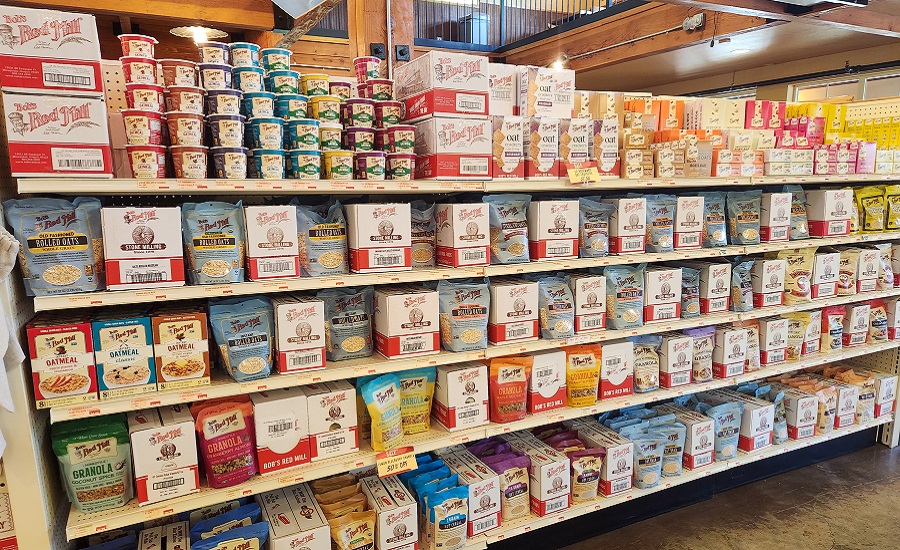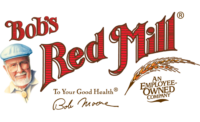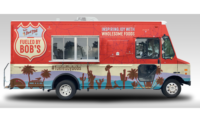Historic whole-grain manufacturer Bob’s Red Mill reportedly looked for many years to use collaborative robots for palletizing tasks. However, it wasn’t able to find a solution meeting the speed, payload, or reach requirements until the release of the UR20. The new, larger cobot from Universal Robots now successfully meets the required cycle times at the company, freeing up four operators while helping propel company growth.
Inspiring joy with wholesome foods—that’s the mantra at Bob’s Red Mill in Milwaukie, OR, where Engineering and Fabrication Manager Nick Chow points out quartz millstones grinding whole grains at slow speeds and cool temperatures: a process, that not only preserves the nutrients but also the fresh taste. The company has grown from humble beginnings in 1978, when Bob Moore and his wife Charlee first started milling whole grain flours and cereals, to an approximately 800,000 square-foot facility that employs 700+ workers. The facility makes more than 200 different products distributed across the globe.
Automation fuels growth
While the milling process is based on historic tradition, the company’s packaging and product handling takes a high-tech approach: “Our vision is to double the number of people eating Bob's Red Mill by 2030. Automation will help us reach that goal,” says Chow, who started deploying larger industrial palletizing robots as the manual labor market dwindled during COVID. A solution that worked for the big production lines but did not fit into smaller lines. “We wanted a robot that could operate much closer to operators in more confined spaces,” explains the engineering manager. “Collaborative robots fit that window between traditional industrial robots and hand palletizing, allowing us to be in a small footprint while still enabling our employee-owners to safely interact with the palletizing system.”
Meeting at PACK EXPO
 But when Bob’s Red Mill researched the cobot market, the company was unable to find a solution that met the reach, payload, and speed requirements of their palletizing cell, until Chow stopped by Columbia/Okura’s booth at PACK EXPO last year. “They told me they were working on something secretive and wanted to partner with Bob’s Red Mill,” says Chow. As it turned out, the secret was the soon-to-be-released UR20 cobot that Columbia/Okura, a partner of Universal Robots (UR), was incorporating into their turnkey palletizer; the miniPAL+. “We had already worked with Bob’s Red Mill, deploying larger robots, and knew the UR20 would be a perfect fit for their smaller cells,” says inside sales specialist at Columbia/Okura, Parker Morris-Pinson.
But when Bob’s Red Mill researched the cobot market, the company was unable to find a solution that met the reach, payload, and speed requirements of their palletizing cell, until Chow stopped by Columbia/Okura’s booth at PACK EXPO last year. “They told me they were working on something secretive and wanted to partner with Bob’s Red Mill,” says Chow. As it turned out, the secret was the soon-to-be-released UR20 cobot that Columbia/Okura, a partner of Universal Robots (UR), was incorporating into their turnkey palletizer; the miniPAL+. “We had already worked with Bob’s Red Mill, deploying larger robots, and knew the UR20 would be a perfect fit for their smaller cells,” says inside sales specialist at Columbia/Okura, Parker Morris-Pinson.
Chow was already somewhat familiar with Universal Robots. “We have been eyeing UR cobots for a long time; I liked all the little case studies they do, whether it's loading CNC machines or using them in applications like ours. We appreciate the simplicity, their track record, and the out-of-the-box features,” he says, recalling his excitement at PACK EXPO when he learned that a UR cobot meeting his cycle time and payload was waiting in the wings. “We tried another cobot that was too sluggish to keep up with our production rate, so we kept hoping that UR would develop a bigger, faster cobot like this,” says Chow.
Keeping up with production rates
Columbia/Okura’s new miniPAL+ is a turnkey palletizing system that includes the UR20 cobot arm, safety area scanners, radar, guarding, built-in pallet jack pockets, the CPT vacuum gripper from PIAB, and PALLY; palletizing software from Rocketfarm, certified through Universal Robots’ UR+ platform for UR cobots.
When the miniPAL+ hit the production floor at Bob’s Red Mill, it just took a couple of hours to unbox and bolt everything together. “Compared to the week-long installation of a traditional industrial robot, the UR20 implementation is much quicker,” remarks Chow, who will have the miniPAL+ handle up to 14 cases a minute. “Our current production requires 7-8 cases per minute, but we are aiming for a 10-12 case rate, so with 14-case-per-minute capacity, we can also account for the time it takes to add slip sheets in between each layer and allow the cobot to catch up if needed,” he says, adding how the UR20’s 20kg (44.1lbs) payload enables the company to double-pick boxes that each weigh between 4-10lbs.
Eliminates 7th axis
Though he had expected a bigger cobot, Chow was taken aback when he first looked up at the outstretched UR20 arm, delivering a 1750mm (68.9in) reach capacity. “I was surprised! It's a hefty cobot that gave us confidence it would be robust enough to keep up,” he says, emphasizing how the added reach also eliminates the need for a vertical 7th axis lift column, commonly used in smaller cobot palletizers to move the cobot arm up and down: “At 81in, our pallets are a little taller than average, but the UR20 allows us to easily reach the back corners without us having to first elevate the cobot arm with a 7th axis, which would eat into our rate. Now we can just quickly move into position.”
Safety, speed, and optimized footprint
 The miniPAL+ is caged on three sides with a small opening for the infeed conveyor on the back. The wide-open front allows interaction with the cell; whenever a worker or a forklift enters the cobot’s work envelope, the motion is detected by an area scanner that slows the cobot down to 10% speed from 2500mm/second to 250mm/second. In case of collision with the UR20, the cobot’s built-in force and power sensors immediately stop the cobot, preventing injury.
The miniPAL+ is caged on three sides with a small opening for the infeed conveyor on the back. The wide-open front allows interaction with the cell; whenever a worker or a forklift enters the cobot’s work envelope, the motion is detected by an area scanner that slows the cobot down to 10% speed from 2500mm/second to 250mm/second. In case of collision with the UR20, the cobot’s built-in force and power sensors immediately stop the cobot, preventing injury.
All programming happens though the PALLY software directly on the UR20’s teach pendant. “There are a couple of things to learn in terms of pallet pattern design, box sizes, and layouts, but it's pretty simple and easy to operate,” says Columbia/Okura’s Morris-Pinson, who helped train all four shifts of the maintenance team at Bob’s Red Mill. “It took roughly 45-60 minutes to get us all trained through a multitude of scenarios,” says Chow, who expects to do hundreds of product change-overs with the miniPAL+: “Today we’re packaging powders, but we can change over to granular products in a matter of minutes.”
Online training with the UR Academy
Chow’s first UR training was actually six years back when he went through the free UR Academy training modules online. “We wanted to see if the interface really was as good as we thought it was. When we looked at all of the options to use collaborative robots, the UR Academy ended up being a big determining factor for us,” he explains as he scrolls through a module on how to control conveyors. “The training is easy and well thought out. Anyone from the operator level can learn how to operate a Universal Robot.”
Operators freed from ‘boring tasks’
Bob’s Red Mill is employee-owned, a fact that Chow explains has fueled employee acceptance of new technologies: “The employee owners here at Bob's were really excited to see this palletizing technology come to their production line. If you are producing well, we all get a share of the company profits. Automation is key in helping us grow and share our profits through profit sharing, while also reducing injuries so everybody goes home safely.” The miniPAL+ solution has freed up four operators over four shifts in the company’s 24-hour operation. “Instead of stacking pallets all day long, the operators can now focus on more value-added tasks, such as quality inspection, instead of something that’s boring,” says Chow.





